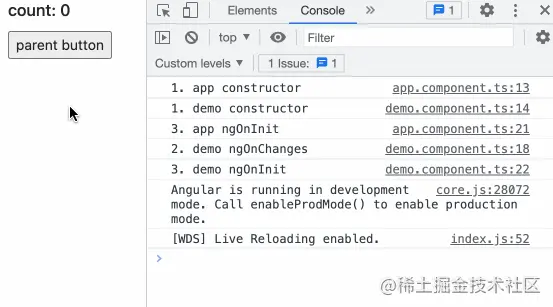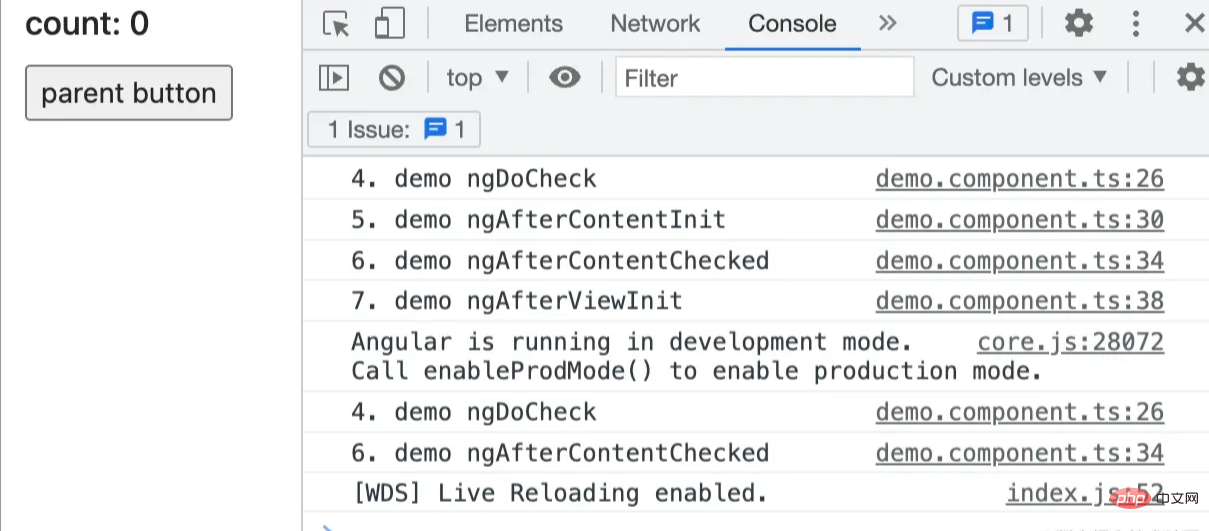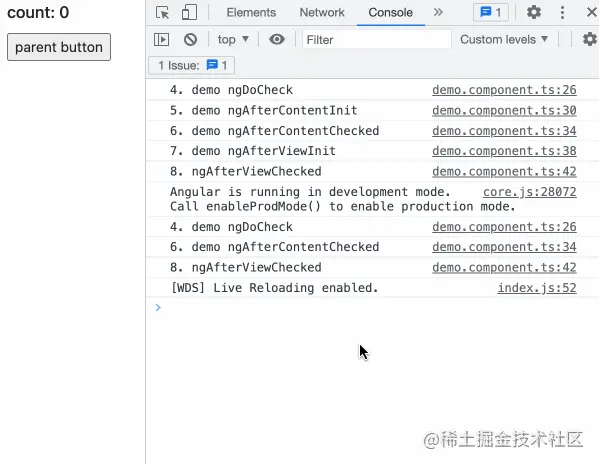使用angular進行開發時,避免不了需要接觸生命周期,下面本篇文章就來帶大家一起聊聊Angular中的生命周期,希望對大家有所幫助!

接觸過 react 和 vue 開發的讀者應該對生命周期這個概念不陌生。我們在使用 angular 開發的過程中,是避免不了的。【相關教程推薦:《angular教程》】
組件從開始建立到銷毀的過程中,會經歷過一系列的階段。這就是一個生命周期,這些階段對應著應用提供的 lifecycle hooks。
那么,在 angular 中,這些 hooks 都有哪些呢?了解它們,對你編寫程序應該在哪里編寫,很重要。
angular 中,生命周期執行的順序如下:
- constructor 【常用,不算鉤子函數,但是很重要】 - ngOnChanges【常用】 - ngOnInit【常用】 - ngDoCheck - ngAfterContentInit - ngAfterContentChecked - ngAfterViewInit【常用】 - ngAfterViewChecked - ngOnDestroy【常用】
為了解說和驗證,我們用 angular-cli 生成一個 demo 項目。
constructor
在 es6 中的 class 初始化對象的時候,constructor 會立即被調用。
class Person { constructor(name) { console.log('be called') this.name = name; } } let jimmy = new Person('jimmy'); // be called
angular 的組件本身就是導出一個類。當這個組件被 new 起來的時候,會獲取 constructor 中的預設的值。
ngOnChanges
當我們有外部參數更改的時候,我們就會執行 ngOnChanges,也就是說組件中有 @Input 所綁定的屬性值發生改變的時候調用。
簡單說,父組件綁定子組件中的元素,會觸發這個鉤子函數,可以多次出發。這在下面的 ngOnInit 總會介紹。
ngOnInit
這個方法調用的時候,說明組件已經初始化成功。在第一次 ngOnChanges() 完成之后調用,且只調用一次。
// app.component.ts export class AppComponent implements OnInit, OnChanges { constructor() { console.log('1. constructor') } ngOnChanges() { console.log('2. ngOnChanges') } ngOnInit() { console.log('3. ngOnInit') } }
打印的信息如下:

咦?怎么沒有打印 ngOnChanges 中的鉤子函數信息呢?
上面已經說過了,需要觸發條件 @Input 的屬性值改變的時候。我們來修改一下:
<!-- app.component.html --> <div> <app-demo></app-demo> </div>
// app.component.ts // AppComponent 類中添加屬性 public count:number = 0;
<!-- demo.component.html --> <h3>count: {{ count }}</h3>
// demo.component.ts export class DemoComponent implements OnInit, OnChanges { @Input() public count: number; constructor() { console.log('1. demo constructor') } ngOnChanges() { console.log('2. demo ngOnChanges') } ngOnInit() { console.log('3. demo ngOnInit') } }

當通過 @Input 將值傳遞給子組件 demo 的時候,就會觸發 demo 組件中的 ngOnChanges。
當 @Input 傳遞的屬性發生改變的時候,可以多次觸發 demo 組件中的 ngOnChanges 鉤子函數。
<!-- app.component.html --> <div> <app-demo [count]="count"></app-demo> <button (click)="parentDemo()">parent button</button> </div>
// app.component.ts parentDemo() { this.count++; }

ngDoCheck
當發生變化檢測的時候,觸發該鉤子函數。
這個鉤子函數,緊跟在每次執行變更檢測時候 ngOnChanges 和首次執行執行變更檢測時 ngOnInit 后面調用。
// demo.component.ts ngDoCheck() { console.log('4. demo ngDoCheck') }

這個鉤子函數調用得比較頻繁,使用成本比較高,謹慎使用。
一般使用 ngOnChanges 來檢測變動,而不是 ngDoCheck
ngAfterContentInit
當把外部的內容投影到內部組件,第一次調用 ngDoCheck 之后調用 ngAfterContentInit,而且只調用一次。
// demo.component.ts ngAfterContentInit() { console.log('5. demo ngAfterContentInit'); }

ngAfterContentChecked
ngAfterContentChecked 鉤子函數在每次 ngDoCheck 之后調用.
// demo.component.ts ngAfterContentChecked() { console.log('5. demo ngAfterContentChecked'); }

ngAfterViewInit
視圖初始化完成調用此鉤子函數。在第一次 ngAfterContentChecked 之后調用,只調用一次。
這個時候,獲取頁面的 DOM 節點比較合理
// demo.compoent.ts ngAfterViewInit() { console.log('7. demo ngAfterViewInit'); }

ngAfterViewChecked
視圖檢測完成調用。在 ngAfterViewinit 后調用,和在每次 ngAfterContentChecked 之后調用,也就是在每次 ngDoCheck 之后調用。
// demo.component.ts ngAfterViewChecked() { console.log('8. ngAfterViewChecked') }

ngOnDestroy
組件被銷毀時候進行的操作。
在這個鉤子函數中,我們可以取消訂閱,取消定時操作等等。
<!-- app.component.html --> <app-demo [count]="count" *ngIf="showDemoComponent"></app-demo> <button (click)="hideDemo()">hide demo component</button>
// app.component.ts public showDemoComponent: boolean = true; hideDemo() { this.showDemoComponent = false }
// demo.component.ts ngOnDestroy() { console.log('9. demo ngOnDestroy') }

PS: 不知道讀者有沒有發現,調用一次的鉤子函數都比較常用~
【完】
 站長資訊網
站長資訊網